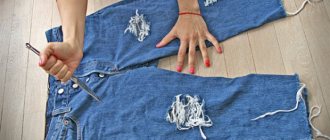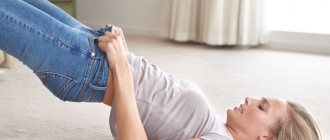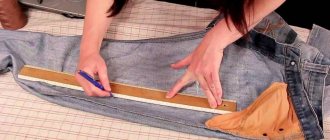An exclusive item can make you stand out from the crowd and make you the object of admiring glances. You don’t have to pay exorbitant sums for individuality. To become the owner of unique jeans, you can decorate any model you like yourself.
Today we will learn how to make ripped jeans at home, which will not be inferior in their sophistication to a pair from the most famous brand.
Correct workpiece style
Before we move on directly to the process, let’s go through our wardrobe in search of exactly the thing that is ideal for experimentation.
- Cross regular fit jeans off your list. Such wardrobe elements will look old-fashioned, and holes in the fabric will seem like the result of an unfortunate fall.
- Stretch pants will also be unsuccessful. The stretchy material will not physically produce beautiful cuts, and the holes will resemble arrows on nylon tights.
- Very thick fabric will make the process of turning pants into a fashion item quite labor-intensive.
- Prints, embroideries and designs, as well as bright patterns look interesting, but additional elements overload the overall composition.
- Ideal candidates for transformation are narrow or wide pants, like boyfriend pants. These trousers for young people perfectly withstand all the “bullying” of themselves, without turning into the clothes of a homeless tramp.
Whitening denim
The latest fashion is jeans with streaks of color and bleached in various parts. To lighten the usual shade of the material, it must first be boiled with a small amount of bleach.
You can also lighten only some areas, for example, the abrasions themselves. To do this, dilute the bleach with a small amount of water and apply it to the denim using a cotton sponge or sponge for 10-15 minutes. After this, this composition must be washed off under running water, and the jeans are washed once again.
Fashion tips for creating holey pants
Most people try to make cuts at the knees, but you can tear the fabric anywhere.
- If you make the cut slightly above the knee, the hole will not get wider and larger each time you bend the knee.
- Cuts that are too high expose the underwear. Men should watch this especially closely.
- If you wash your trousers immediately after decorating, you will loosen the threads even more, so the trousers will look even more frayed.
- Incisions that are close to the seams can cause the latter to come apart.
- You can pull out single fibers with extreme precision using a sewing needle.
- If instead of cardboard you put a piece of brick in your pant leg, you will significantly speed up the process of washing the fabric.
Which color is better?
Current fashion has made it possible to have not only blue or light blue jeans, but also any other shade. In this regard, many people have a question about whether the color of trousers is decisive when making holes in them.
There are some points to note. Actually, the color of jeans doesn't really affect the appearance of the holes made on them. Another thing is that colored trousers are sometimes not jeans at all, but are only called that by their owners out of habit. To form a beautiful flaw on trousers, the density and structure of the fabric are important, and therefore material with thin fibers will not be suitable.
When it comes to colored mid-weight jeans, small slits at the knees with minimal fringing and minor fraying will look great on them.
Also, some are concerned about the question of how to tear black jeans at the knees. In fact, making beautiful holes on black trousers is no different from similar work with blue or light blue ones.
Creating abrasions on trouser fabric
To make fashionable scuffs on jeans yourself, you need to have the following tools on hand:
- pants directly;
- sandpaper and block;
- a piece of pumice;
- grater;
- small hard board.
Step-by-step fashionable decor is carried out according to the following scheme:
- Mark the selected area for decoration and mark it with chalk or soap.
- Take a piece of wood and put it inside your trouser leg under the place where the wear will be in the future.
- We proceed to the main stage - the intended place is rubbed using the selected device. Do not rub with force, because in the place of supposed fashionable wear and tear you may end up with an unnecessary hole.
- A pumice stone and a trowel will help in obtaining a worn finish with fluffy fringe along the edges. This softens the image and at the same time gives it some audacity. Using an emery block or paper you will create designer wear.
- At the decorating stage, decorate the scuff with rhinestones, rivets or paper clips.
And now the video
Cut-up jeans models have been on the fashion Olympus for several seasons now.
It looks extremely stylish and impressive. You can immediately buy cut or torn jeans, but you can make the decor yourself.
First you need to outline the places where future cuts will be placed. Remember that this decor will be the main accent, so it should be done beautifully and neatly. You should not ignore the preparation process, the future appearance of your jeans depends on it.
Hole jeans with "Noodle" effect
As for holes, their creation is more labor-intensive. The following tools will help you create ripped jeans with your own hands:
- a piece of plywood;
- stationery knife or blade;
- eyebrow tweezers or any other;
- scissors;
- interlining.
You can make a masterpiece out of jeans for yourself using the following scheme:
- Any denim pants are woven using colored longitudinal and white transverse fibers. Before the procedure, fix a piece of plywood inside the leg.
- Using a blade or pocketknife, make two cuts along the cross grain at a distance of 3-4 cm.
- Take scissors or tweezers, use them to carefully pick up and pull out the white threads along the edges. Use caution and patience.
- After this, using the same tweezers between the cuts, pull out all the blue threads that are located perpendicular to the bottom ones. Initially, pull one thread at a time, at the end of the manipulation you can pull it out in a bunch.
- Fix the edges of the resulting hole from the inside with non-woven fabric to avoid losing the shape of the product.
- It is interesting to make a model with numerous long cuts that are free of blue threads.
You can decorate the pants by fixing lace or bright pieces of fabric on the reverse side; this will add audacity and attract attention to their owner.
Marking
Trying on jeans will help determine the locations for future slits. Put the product on and mark the fabric with chalk. The sizes of the holes can vary: from microscopic to solid. The more slits are placed on denim pants, the more informal they will look.
After organizing the markings, you need to hang the denim pants on hangers and look at them from a distance. This will allow you to evaluate what effect will be obtained after further processing of the denim.
Decor of torn jeans using the “Grunge” method
Ripped jeans at home in this style will decorate both men's and women's trousers.
To decorate the trousers yourself, we will need:
- small board or plywood;
- scissors;
- stationery knife;
- a piece of pumice.
A step-by-step diagram of how to make jeans ripped consists of the following steps:
- Secure plywood or board under the desired area inside the trouser leg.
- Make 6-9 slits along the cross grain, about half the length of the pant leg.
- It’s better to use a stationery knife, because only with its help you will achieve the effect of maximum negligence. You can make slits of different lengths.
- After this, rub the holes with your hands and pull out a few blue fibers from them.
- Process the bottom of the trousers. Trim the edge, and rub the resulting edge with a piece of pumice to a careless, disheveled look.
- In the same way, process the cuts on the pockets and belt to completely enhance the item, create integrity and completeness of the image.
How to make shorts or breeches from regular jeans
An easy way to update old jeans is to cut them down to shorts or breeches. In this case, you need to outline the height of the future product and break it along the transverse thread. If the shorts are intended to be made without further processing, but with torn edges, then no allowances will be required. They are necessary if, according to the model, a gate is required. For this design, add 3-7 cm to the desired length and trim off the excess. This process will look like this step by step:
- Lay the finished jeans out on a flat surface without folds.
- Mark with chalk or a pencil the place where the excess length will be trimmed.
- We tear off the jeans along the line with our hands or with scissors.
- Additionally, we make holes or abrasions (optional), taking into account that the color of the longitudinal thread will be lighter than the main shade of the trousers.
- Fold the edge or leave it torn. Ready!
"Cut knees" on black jeggings
Many jeans fans will have a new item in their wardrobe in 2022, among noodles and other shabby pants - black jeggings with slits at the knees. Buying a trendy item in a store is expensive, but creating such fashionable trousers with your own hands can be as easy as shelling pears at maximum cost.
The action plan is as follows:
- Put on your trousers and mark the location of the future cut with a piece of soap.
- Take off the item and put cardboard or a board in the trouser leg.
- Use a utility knife to cut the fabric using sharp movements along the marked line.
- Straighten the cut and use your fingers to pull out the excess threads.
We tear beautifully - option 2
We mark the area of the future hole and make several horizontal slits with a stationery knife at intervals of no more than 1 cm. Next, use the tip of nail scissors to separate the white threads, working carefully so as not to tear them.
All that remains is to use a stationery knife to scrape off the small scraps of blue vertical threads - this is done quite easily. Upon completion of work, clean the hole and the entire surrounding area with a vacuum cleaner.
Secrets to creating the right holes in your knees
Torn knees have not gone out of fashion for decades now. There is a certain specificity in creating an image, because it’s no secret that in such popular places the fabric unravels instantly. We advise you to use a trick and follow a certain algorithm.
- Put on your pants. Place a small dot in the middle of the knee with chalk or soap.
- Mark the future hole in the shape of an eye, the center of which will be that same point. Carefully cut along the outline.
- Process the edges using a special technique. Treat them with a nail file or sandpaper. Wet the edges and roll them up and down a little, securing with pins. Let them dry.
- Use a grater to create abrasions on the remaining part of the knee.
- This shape will allow the cut to maintain its shape longer.
As you have already seen, creating a beautiful designer item is easy and simple with your own hands. Handmade, made according to an individual project, will make your look fashionable and unique.
We outline a work plan
First, let's decide on the number of holes and their location. Equally important will be the size of each hole, as well as its type.
It could be:
- through hole - a piece of arbitrarily shaped fabric simply cut from jeans;
- a hole is not such an obvious hole; horizontal threads remain in the hole, which play the role of “filler” of the hole;
- fraying is a frayed area framed by small fringe, which is not essentially a hole; such jeans can be worn comfortably even in windy weather.
Where is the best place to make holes?
The placement of cuts on the fabric should be carefully considered, depending on the intended effect. Properly aged jeans can emphasize the shape of the legs, disguise defects, and distract attention from problem areas of the figure. Before work, you should find photographs of pants with artificial tears to understand how to correctly position the cuts.
A few general recommendations:
- owners of long slender legs are recommended to make slits in the knee area and in the upper thigh;
- for short girls, small cuts scattered throughout the surface of skinny pants are suitable;
- girls with large hips should opt for classic models, keep the holes rare and place them vertically. The main thing here is not to do them too often, so as not to achieve the opposite effect.
The main mistake in the location of the slots is placing them close to each other. This visually shortens the legs and makes it difficult to achieve the desired effect. And, of course, the cuts should occupy no more than half of the trouser leg, so as not to look vulgar. For the first experiment, it is better to make one or two holes, and then add to the model of ripped jeans if you like the result.











